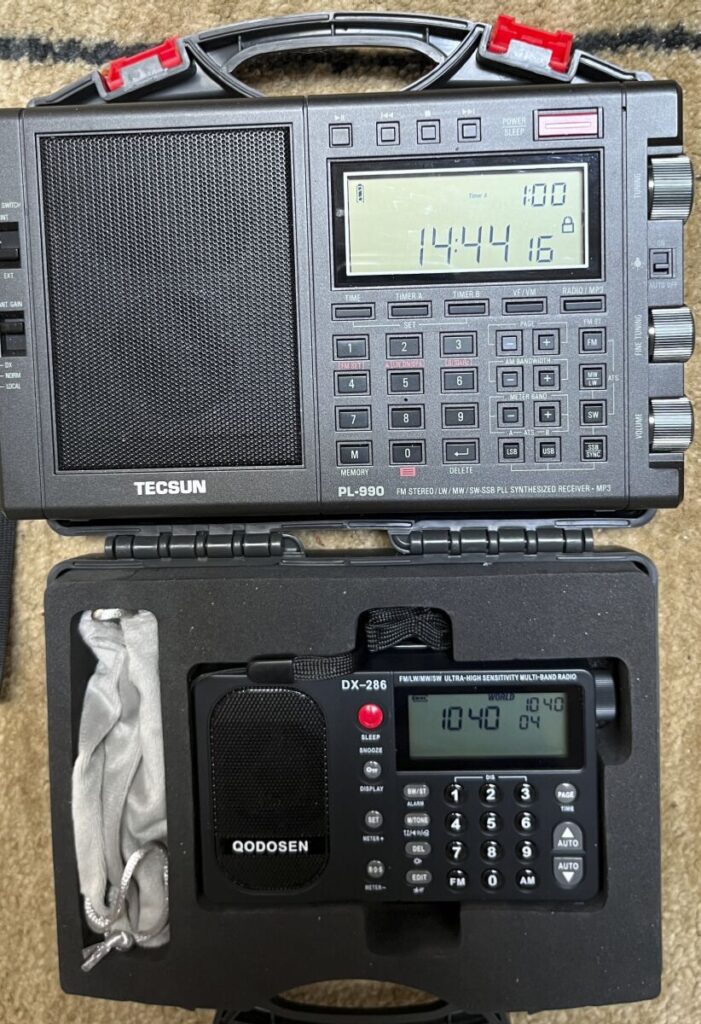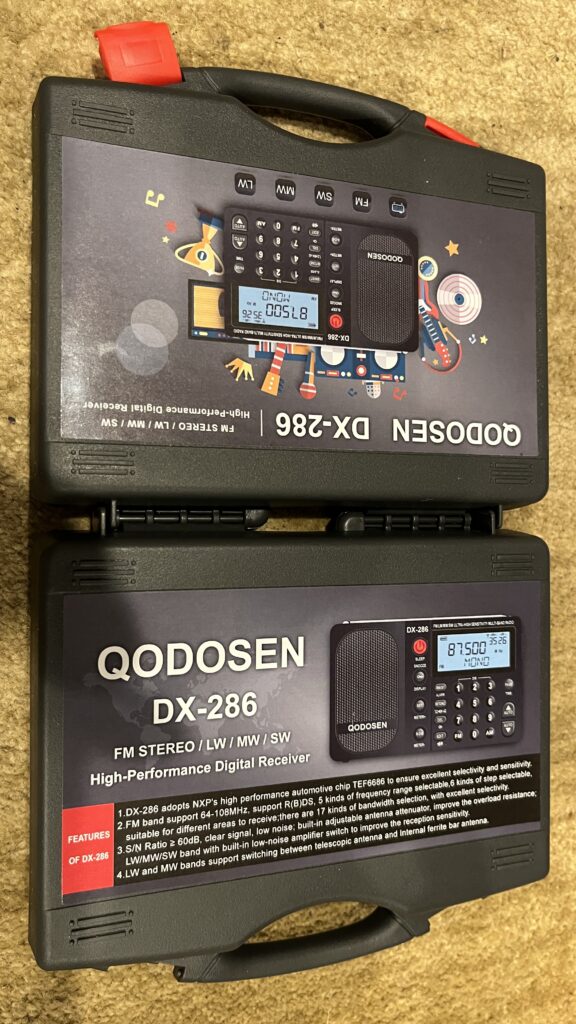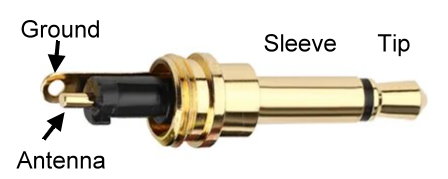Disclaimer: Qodosen provided me with this radio to test. I like it just as much as the SR-286 that I paid for myself and have written about extensively.
This is not a product review because it is essentially the same model as the SR-286, so the review of that radio applies to the DX-286. The difference is in packaging, small firmware updates and a much improved product manual. All that follows.
Unboxing
The predecessor SR-286 didn’t come in a box. That’s remedied in the new model. I’ve decided to link to an excellent unboxing video by Andre from the SWL YouTube channel. One shouldn’t mess with perfection. Andre has some cool videos showing what he can receive in South Africa on an interesting variety of radios.
But not only does it come in a nice box, it also comes in a very nice hard-body case! The case looks large in the picture but it’s no wider than a Tecsun PL-990 radio without a case. This should be great for travel.


Included:
- Product box
- DX-286 Radio
- USB Mini charging cable
- Plush carry bag
- Protective plastic sleeve
- 32-page user manual (including 2-page fold-out quick start guide)
- Hard plastic carry case
- Warning sticker: Use a regular 5V power source, not a power distribution fast charger.
- Full-sized product identification stickers that can be applied to the carry case. I do not recommend applying these stickers. They peel off easily.
Here’s what the carry case looks like with the stickers on it.

Hints:
- The LCD display comes with a protective plastic sheet. It’s not easy to see, but it can be peeled off.
- The DX-286 does not come with the required 18650 button-top battery. Order one with the radio if you don’t have a spare already. The radio uses a fair amount of energy, so I recommend a higher 3000 mAh capacity battery.
Comparison to the previous SR-286
There are several differences, although nothing major. Physically the radios are the same and they have the same circuitry. They have equal performance.
Packaging:
The SR-286 did not come in a box. There is a radio, a USB-mini charging cable and a nylon fold-over pouch with Velcro closure.
The DX-286 comes in a nice sales box. It includes a printed manual and a hard plastic carrying case. It also includes a plush drawstring bag and the charging cable.
Operation:
The SR-286 required simultaneous multi-key presses for some functions. Common ones have been replaced with single-key long presses.
Tuning:
The SR-286 had a problem with its 200 kHz FM step setting for North America. It landed on even multiples of 100 kHz, while actual stations in NA are on odd multiples (90.1, 90.3…). This is fixed in the DX-286. For the SR-286, just use the 100 kHz spacing (which is what most radios have anyway). The DX-286 also adds new 250 kHz and 30 kHz FM tuning step.
One additional FM frequency band range was added on the DX-286, 76-95 kHz for Japan. This band is contained within the existing 76-108 band on the SR-286, so no big deal.
The big difference is that the radio is $79.99 and it’s available on Amazon.
Setup
Before the user can get full benefit of the radio, a few one-time settings are necessary. They are in the manual, but I’ll put them together here.
Operational settings
With the radio off, long press the SET button for 2 seconds to enter settings mode. There are a groups of settings; select the group with the tuning knob; select the individual setting value by repeatedly pressing the SET button to scroll through the options. Then use the tuning knob again to advance to the next setting.
I recommend these settings for North America:
- MW — 10K (MW step)
- 87.5 – 108 (FM frequency range)
- FM 200K (FM step in FAST mode)
- RBDS (FM RDS/RBDS for North America)
- FMDE-75µS (FM pre-emphasis for North America)
- LW-ON (Longwave ON!)
Press Page/Time to exit the setting mode.
Clock
Setting the clock is not terribly complicated, but I always do it wrong the first time. Follow the instructions in the manual (Page 22-24), or the ones following. Just remember to enter your local time, not GMT/UTC . The radio supports only the 24-hour format, no AM/PM.
With the radio off:
- Select your local time zone.
- Long-press the M/Tone button for 2 seconds until the time zone list is displayed.
- Turn the tuning knob to select your local time zone.
- Press Page/Time to exit the mode.
- Set your local time.
- Long press the Page/Time button to enter hour setting mode.
- Select the hour with the tuning knob.
- Press the Page/Time button to enter minute setting.
- Select the minutes with the tuning knob.
- Press the Page/Time button to exit time setting mode.
- If the RDS option is turned on in radio settings, then an option is available to automatically set the time from RDS. I do not recommend the automatic setting because some stations have incorrect time.
- Set the time zone to GMT +0.
- Long-press the M/Tone button for 2 seconds until the time zone list is displayed.
- Turn the tuning knob to select GMT +0.
- Press Page/Time to exit the mode.
Manual
Quite a lot of work has gone into a much more polished and professional-looking manual. Some parts of it seem to have been composed with an AI tool, like ChatGPT, but there’s nothing wrong with that. There are a few minor rough spots in the translation, but overall I give the manual an “A” grade. The print is good sized and very readable. I prefer the PDF version because it’s searchable.
Errata:
The manual (p. 12) says that RDS information is displayed in the order PS/PTY/RT/DATA/PI, but it is actually PTY/PS/RT/DATA/PI.
The chart at the top of page 10 has column headings “FAST SPEED ON” and “SLOW SPEED ON.” The actually setting names are “SPEED ON” and “SPEED OFF” as described on page 9.
The PDF manual preceding has a 31st page not in the printed manual, with contact information and a website address. As of this writing the website is under construction.
Specifications and sensitivity
The DX-286 has impressive specifications

The shortwave specification is the same as the Tecsun PL-330, but the FM/MW/LW figures are markedly better, reflecting where the real value in this radio is. External antenna sensitivity specifications for LW and MW are typically not published, and few radios even support an external antenna on those bands.
I found that with a simple 20 ft. antenna up a tree and an earth ground, I got phenomenal reception on MW and LW. FM sensitivity is 6 times the value for the PL-330 with the telescopic.

I went out about 9 AM local time to do a shortwave band scan. This is a dead time of day. I picked up Radio Marti (not that far away very strong). CFRX in Toronto was listenable on the telescopic. There was one good station that I think was Chinese, but it signed off after a minute. What caught my attention was WWV in Ft. Collins, Colorado, sharing 15 MHz with WWVH in Hawaii. I caught IDs for both of them. The video below, with a 20-ft. antenna was just interesting. I could get both stations with the whip antenna, but the external antenna made for a better recording.
The important thing to remember about specifications is that no matter how sensitive the radio is, it can perform no better than what the local noise level allows.
Here’s the DX-286 in central Virginia just after sunset receiving what I believe is the Voice of America broadcasting from Kuwait to Tibet. This is with the telescopic antenna.
Hints:
- Holding the radio in your hand improves reception with the telescopic antenna.
- An earth ground makes a huge improvement on LW/SW, but not on shortwave.
What the DX-286 does particularly well
I wrote an entire blog post on the myriad ways to tune the radio: Qodosen SR-286 Tuning Tutorial. Two things that I particularly like is the ability to tune MW/FM with the knob so that every detent on the knob is a potential station. That’s perfect for scanning the band and recording every station that’s available, something I like to do with new radios. And I like the AUTO mode where one detent advance on the tuning knob searches for the next available station.
I very much like the way that I can pick up the radio and tune to a station with minimal fuss. Just punch in the number and hit AM or FM. The radio figures MW/SW/LW for you. And if the radio is already in the right band, the AM/FM button isn’t required.
I like the adjustable squelch on all the bands. I like being able to adjust the sensitivity on ATS memory scans. I like a mute button. I like being able to see local time and UTC together. I like the ability to change tuning modes by pressing on the tuning knob.
Room to improve
I really like this radio and how it works. There aren’t many things that could be done to improve the radio without making it a different radio. Sure folks want SSB, but that would be a different radio. Some people would prefer a USB-C charging connector. And most people don’t like soft muting (chuffing sound when tuning from station to station) that’s present on all DSP chip radios — it doesn’t bother me.
I’m more interested in what the radio could to better without changing it physically.
One significant improvement would be the display of the FM radio call sign with RBDS. It’s embedded in the DATA segment in North America. The Eton Elite Executive is the only portable radio I know of that displays this information. Check my article RDS / RBDS: FM on Display for more on that.
A daylight savings time / summer time feature is common among clock radios like this one, but I don’t recall any shortwave radio with a clock having the feature. And some of the clock radios like the one below make the switch automatically.
Of course I set my shortwave radios to UTC where it doesn’t matter. Still, the DX-286 has a dual time zone feature and it would be nice if one could just make a setting to switch the local time between standard and summer. Daylight savings time is in effect right now in the US, so when I set the time for the clock, I couldn’t use my actual time zone (NYC – 5) because that’s an hour off this time of year.
In PAGE mode the DX-286 displays the word “PAGE” and the page number at the bottom of the screen, conflicting with R(B)DS data that appears in the same place. It would be nice if the display switched to R(B)DS a second or so after tuning the station on FM in PAGE mode.
I think the ability to set the automatic gain control (AGC) timing might be useful.
Some have complained about the radio reverting to the default bandwidth after powering on, rather than retaining the previous value. I can see the value of that, although it’s not an issue for me.
Conclusion
I have a number of good radios I can grab when I want to listen to something: Tecsun PL-330, PL-660, PL-990, XHDATA D-808, XHDATA D-109, Sangean ATS-405, Sihuadon R-108, Eton Elite Executive, LiJiANi Rd239 and Raddy RF75A. Some of those have special features like AIR band, Weather or VHF; however, those are not features I use much. For my actual day-to-day listening I grab the Tecsun PL-990 for SSB and the Qodosen SR-286/DX-286 for everything else. I choose the Qodosen because it is sensitive on shortwave, it is very compact and fits in a shirt pocket, frequency entry is super convenient, the speaker is good, the display and button labels are very easy to read and I really like the AUTO tuning mode. I also like the fact that its ATS scans are much faster than other radios.


 [robot emoji] symbol. Content comes most often from Microsoft Copilot, bit may also come from Perplexity, ChatGPT or Deep Seek.
[robot emoji] symbol. Content comes most often from Microsoft Copilot, bit may also come from Perplexity, ChatGPT or Deep Seek.
Hi Kevin, I was wondering what the model of 20ft wire antenna is that you have mentioned using with the jack on your 286’s? Cheers.
It’s just 20 feet of wire. I put an insulator on a tree and connected the antenna to that and sloped the antenna down to a table on the patio. I took an old audio cable and cut it; I connected two alligator clips to the exposed leads. I plug the audio plug into the radio and clip the clips onto the antenna, and sometimes to a ground wire I have there.
Update: I’ve had this radio for a month and a half now, have used it daily, and it continues to impress. It excels at AM, FM and SW, and regularly surprises me with interesting SW catches. I recommend this radio highly.
This is an outstanding little radio. The first SW radio I bought is the XHData D-109WB, which I use every day and highly recommend. I soon added the Qodosen, and as a pure radio it is even better than the D-109WB.
The DX-286 has a nice case, with buttons that feel nice and work well. The sound from the speaker is clear and crisp. Sound from earbuds is really nice. A very, very sensitive receiver for AM, FM and SW DX’ers.
Hola, compré una sr286, la batería dura aprox unas 8 horas,
Probé con baterías nuevas, es lo mismo, eso es normal? Tiene tanto consumo?
Depending on the battery capacity, 8 hours sounds reasonable. If you have a genuine 3350 mAh battery, you might get 12-15 hours at moderate volume.
Excellent review. I ordered one today and it should be here in two days. I’m a lifelong MW DXer and can’t wait to try it out. I replaced an aging (30 yr. old) Superadio III with the CCrane EP Pro. A bit large to lug around all the time. Thanks again!
How to contact Quodosen?
Qodosen can be reached by email at qodosen@qodosen.com.
Hi Kevin, thank you for this very clear write-up about the DX-286, I enjoyed reading it! I share your views, I have found that for day-to-day listening, the Qodosen SR-286 or DX-286 are always my go-to radios now. Just so easy to operate (once you get the hang of it), so compact, and so good.
Thank you for the link to my unboxing video! I am linking back to this article from my video, many people have asked me about the clock function in particular. A lot of people seem to struggle with getting it right. I did too, the first time I will refer them to this article next time they ask, nicely explained here!
I will refer them to this article next time they ask, nicely explained here!
I believe you’re right, the TEF6686 chip limits coverage to 27 MHz.
The spec sheet for the chip is available here: https://www.nxp.com/docs/en/brochure/75017468.pdf
That spec sheet indicates there’s another version of the chip, the TEF6688, that supports HD radio and DRM. For the US/Canada market, adding HD would be a useful addition. I’d suppose such a radio would be far more sensitive than any existing portable HD radios (meaning: Sangean).